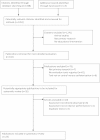Measuring competence in central venous catheterization: a systematic-review
- PMID: 24505556
- PMCID: PMC3909608
- DOI: 10.1186/2193-1801-3-33
Measuring competence in central venous catheterization: a systematic-review
Abstract
Objectives: Central venous catheterization is a complex procedural skill. This study evaluates existing published tools on this procedure and systematically summarizes key competencies for the assessment of this technical skill.
Methods: Using a previously published meta-analysis search strategy, we conducted a systematic review of published assessment tools using the electronic databases PubMed, MEDLINE, Education Resource Information Center (ERIC), the Cumulative Index to Nursing and Allied Health Literature (CINAHL), Excerpta Medica, and Cochrane Central Register of Controlled Trials. Two independent investigators abstracted information on tool content and characteristics.
Results: Twenty-five studies were identified assessing a total of 147 items. Tools used for assessment at the bedside (clinical tools) had a higher % of items representing "preparation" and "infection control" than tools used for assessment using simulation (67 ± 26% vs. 32 ± 26%; p = 0.003 for "preparation" and 60 ± 41% vs. 11 ± 17%; p = 0.002 for "infection control", respectively). Simulation tools had a higher % of items on "procedural competence" than clinical tools (60 ± 36% vs. 17 ± 15%; p = 0.002). Items in the domains of "Team working" and "Communication and working with the patient" were frequently under-represented.
Conclusion: This study presents a comprehensive review of existing checklist items for the assessment of central venous catheterization. Although many key competencies are currently assessed by existing published tools, some domains may be under-represented by select tools.
Keywords: Catheterization; Central venous; Checklist; Clinical competence; Medical education.
Figures
Similar articles
-
The application of health literacy measurement tools (collective or individual domains) in assessing chronic disease management: a systematic review protocol.Syst Rev. 2016 Jun 7;5:97. doi: 10.1186/s13643-016-0267-8. Syst Rev. 2016. PMID: 27267468 Free PMC article.
-
Student and educator experiences of maternal-child simulation-based learning: a systematic review of qualitative evidence protocol.JBI Database System Rev Implement Rep. 2015 Jan;13(1):14-26. doi: 10.11124/jbisrir-2015-1694. JBI Database System Rev Implement Rep. 2015. PMID: 26447004
-
Beyond the black stump: rapid reviews of health research issues affecting regional, rural and remote Australia.Med J Aust. 2020 Dec;213 Suppl 11:S3-S32.e1. doi: 10.5694/mja2.50881. Med J Aust. 2020. PMID: 33314144
-
Interventions for adults with a history of complex traumatic events: the INCiTE mixed-methods systematic review.Health Technol Assess. 2020 Sep;24(43):1-312. doi: 10.3310/hta24430. Health Technol Assess. 2020. PMID: 32924926 Free PMC article.
-
Psychological interventions to improve self-management of type 1 and type 2 diabetes: a systematic review.Health Technol Assess. 2020 Jun;24(28):1-232. doi: 10.3310/hta24280. Health Technol Assess. 2020. PMID: 32568666 Free PMC article.
Cited by
-
Using Modified Direct Observation of Procedural Skills (DOPS) to assess undergraduate medical students.J Adv Med Educ Prof. 2018 Jul;6(3):130-136. J Adv Med Educ Prof. 2018. PMID: 30013997 Free PMC article.
-
Design and Evaluation of a Low-Cost Bronchoscopy-Guided Percutaneous Dilatational Tracheostomy Simulator.Simul Healthc. 2019 Dec;14(6):415-419. doi: 10.1097/SIH.0000000000000399. Simul Healthc. 2019. PMID: 31804426 Free PMC article.
-
Central venous catheterization training: current perspectives on the role of simulation.Adv Med Educ Pract. 2018 May 25;9:395-403. doi: 10.2147/AMEP.S142605. eCollection 2018. Adv Med Educ Pract. 2018. PMID: 29872360 Free PMC article. Review.
-
Using the Entrustable Professional Activities Framework in the Assessment of Procedural Skills.J Grad Med Educ. 2017 Apr;9(2):209-214. doi: 10.4300/JGME-D-16-00282.1. J Grad Med Educ. 2017. PMID: 28439355 Free PMC article.
-
Delphi Method to Achieve Clinical Consensus for a BPMN Representation of the Central Venous Access Placement for Training Purposes.Int J Environ Res Public Health. 2020 May 30;17(11):3889. doi: 10.3390/ijerph17113889. Int J Environ Res Public Health. 2020. PMID: 32486300 Free PMC article.
References
-
- Standards for educational and psychological testing. Washington D.C: American Educational Research Association; 1999.
-
- Berenholtz SM, Pronovost PJ, Lipsett PA, Hobson D, Earsing K, Farley JE, Milanovich S, Garrett-Mayer E, Winters BD, Rubin HR, Dorman T, Perl TM. Eliminating catheter-related bloodstream infections in the intensive care unit. Crit Care Med. 2004;32(10):2014–2020. doi: 10.1097/01.CCM.0000142399.70913.2F. - DOI - PubMed
LinkOut - more resources
Full Text Sources
Other Literature Sources


